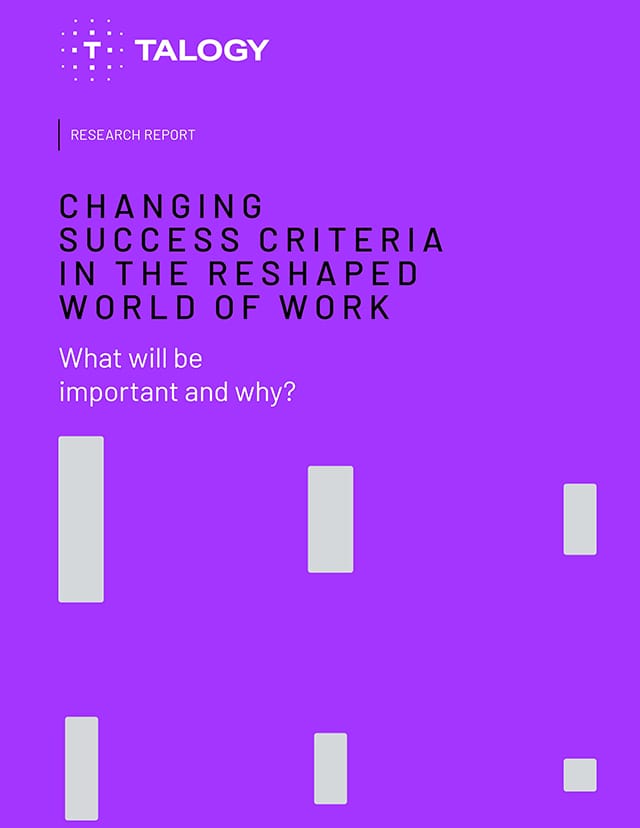Written by Jon Gove, Senior Research Consultant
In this blog, I will explore the remaining three top competencies for the next decade detailed in the research report Key success criteria in the reshaped world of work. This group relates to how we deliver results, overcome obstacles, and adjust to change: change orientation, digital dexterity, and resilience. I’ll discuss why they will be important and some simple tips to help develop these valuable soft skills.
Change orientation
As the saying goes, the only constant is change. We must constantly adjust to ongoing change and advancement in the workplace. We’ve seen organizations quickly adapt to remote working as we entered an unprecedented global pandemic. More recently we’re seeing organizations adjust again to more permanent hybrid working models.
Workplace consultancy, McKinsey, has estimated that up to 375 million workers worldwide will need to change roles or learn new skills by 2030. Much has been written about the willingness, readiness, and capability to change. However, what is clear is that not changing will rapidly not be an option for many.
To keep up, employees and employers alike need to develop a change orientation mentality which we define as maintaining a positive attitude toward change and appreciating the opportunities that change presents.
Tips for change orientation:
- Be prepared for change. Make a list of what might change within your workplace and why, which will help you respond positively and successfully adapt.
- Focus on a workplace change you do not feel as comfortable with. Consider how this could be a positive change and identify the opportunities this change could present, first to the organization, and then to yourself.
- Ask a colleague who responds well to the unexpected how they deal with unplanned changes. Practice the same strategies or coping mechanisms the next time something unexpected happens to you.
Digital dexterity
Hand in hand with change orientation comes a critical need to adopt and leverage technology to positively impact the quality of product, process, and communication.
Building a tech-friendly workplace to foster collaboration among remote workers and grow revenue streams is a top priority for many organizations. According to a recent HBR poll, 87% of business leaders say that ‘digitization’ is a top priority for their organization.
Not that this is straightforward. The same poll shows that 72% of corporate strategists said their company’s digital efforts are missing revenue expectations. Clearly, there is still some way to go to optimize these efforts and realize results, which must start with the people driving these initiatives.
We define digital dexterity as rapidly adopting new technologies – either through adeptly grasping their usage or through understanding their impact – and empowering others to use them as needed. Possessing this competency will only become more critical with every technological development and advancement.
Tips for digital dexterity:
- Recognize the impact of new technology. Encourage others to produce business cases for implementing new technology and set time aside to listen to their pitches. Remember, current practices may not necessarily be the most effective or efficient.
- Participate in sharing technical knowledge with colleagues. Establish a way of passing this knowledge and expertise on to your team and invite your colleagues to share their technical knowledge, too.
- Stay up-to-date with the latest technological developments within your area of expertise. This may include reading and watching relevant material, attending conferences, networking, or professional training.
Resilience
The final key competency for the next decade is resilience. Its inclusion on the list doesn’t need justifying. Bouncing back from setbacks and disappointments was an everyday requirement during the pandemic, and the future is as unpredictable and uncertain as ever.
Human Resource Executive reported last year that 69% of workers said the pandemic was the most stressful time of their career. This presents a challenge as stressed employees are less productive, more easily distracted, and more likely to become ill.
As a result, resilience took center stage as the entire globe navigated constant unpredictability and unforeseen setbacks. We define resilience as bouncing back from setbacks, disappointments, and criticism.
Tips for resilience:
- Don’t take setbacks personally. Sometimes external influences will impact your timeline or plan. When this happens, try not to focus on the negative implications; instead, focus your energy on brainstorming ways to overcome those challenges.
- Don’t lose motivation. Setbacks are inevitable at work. Instead of losing motivation after a setback or obstacle presents itself, volunteer to lead a new initiative or strategy and make sure you apply what you learned from mistakes made last time.
- Remove obstacles and implement solutions. Be aware that – with almost every project – there will be some obstacles to overcome. Don’t give up; take your time and consider alternative solutions to the problem instead of choosing the first solution that presents itself.


